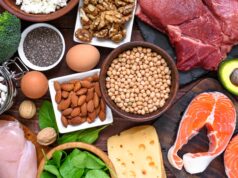Lipids are a type of fat found in foods. They are made up of fatty acids and glycerol. The recommended daily intake for lipids is 20-35% of total calories.
The what foods supply lipids is a question that usually comes up in discussions about food consumption. Lipids are the fats and oils found in our bodies, such as butter, milk, and olive oil.
Topics include food and nutrition, as well as public health.
Similarly, what percentage of one’s diet should include carbohydrates?
sixty-five percent
Similarly, what percentage of a person’s diet should be made up of lipids? Consumers may choose goods with the least amount of saturated fat, trans fats,13 and cholesterol by reading the food label. Most dietary fats should come from polyunsaturated and monounsaturated fatty acid sources to fulfill the total fat guideline of 20 to 35 percent of calories.
What proportion of nutrients should I consume as a result?
Your macronutrient ratio has no bearing on weight reduction. 45–65 percent of your daily calories should come from carbohydrates, 20–35 percent from fats, and 10–35 percent from protein, according to the appropriate macronutrient distribution ranges (AMDR). Find a ratio that you can adhere to, concentrate on nutritious meals, and consume less calories than you expend to lose weight.
Proteins should account for what percentage of total dietary consumption?
Protein should account for 12 to 20% of your total daily calories in a balanced diet. Protein is required by the body for development, maintenance, and energy. Protein may be stored and is mostly used by your muscles.
Answers to Related Questions
What is a food that is high in fat but low in protein?
1 tablespoon of virgin olive oil has 14 grams of fat but no fat or protein. Nuts: Nuts are rich in fat, but they also include protein and carbohydrates. However, the fat in them is good for you and is by far the most important macronutrient. Nuts contain 6 grams of fat, 2.4 grams of carbohydrates, and 2.6 grams of protein per ten almonds.
What are some healthy carbohydrates to eat?
Carbs that are good for you:
- Vegetables: Every single one of them.
- Apples, bananas, strawberries, and other whole fruits
- Lentils, kidney beans, peas, and other legumes
- Almonds, walnuts, hazelnuts, macadamia nuts, peanuts, and other nuts are examples.
- Chia seeds and pumpkin seeds are two types of seeds.
- Choose entire grains such as pure oats, quinoa, brown rice, and other whole grains.
What fruit has the fewest carbs?
The best low-carb fruits are listed below.
- Watermelon. The carbohydrate level of this summer staple is the lowest, with just 7.55 g per 100 g of fruit.
- Berries. Berries are a common option among low-carbohydrate eaters.
- Cantaloupe.
- Avocados.
- Honeydew.
- Peaches.
Is honey a good fiber source?
1. Honey is a good source of nutrients. 1 tablespoon (21 grams) of honey has 64 calories and 17 grams of sugar, which includes fructose, glucose, maltose, and sucrose. It has almost little fiber, fat, or protein (2).
I’m not sure how many calories I should eat.
To maintain her weight, the typical woman requires approximately 2,000 calories per day, and 1,500 calories per day to shed one pound per week. Meanwhile, a typical guy need 2,500 calories to maintain his weight and 2,000 calories to shed one pound each week. This, however, is dependent on a number of variables.
What are the components of carbohydrates?
Carbohydrates. Carbohydrates (also known as saccharides) are simple molecular molecules composed of just three elements: carbon, hydrogen, and oxygen. Monosaccharides (for example, glucose) and disaccharides (for example, sucrose) are tiny molecules. Sugars is a common name for them.
How much sugar should you consume on a daily basis?
The maximum amount of added sugars you should consume in a day, according to the American Heart Association (AHA), is (7): 150 calories per day for men (37.5 grams or 9 teaspoons) 100 calories per day for women (25 grams or 6 teaspoons)
How much protein do I need on a daily basis?
The majority of recognized nutrition organizations advise a moderate protein consumption. The DRI (Dietary Reference Intake) for protein is 0.8 grams per kilogram or 0.36 grams per pound of body weight. For the typical sedentary male, this equates to 56 grams per day.
Is there such a thing as too much protein?
According to most studies, consuming more than 2 g of protein per kg of body weight every day over an extended period of time may create health issues. Intestinal pain and indigestion are two symptoms of eating too much protein. dehydration.
What are some of the most important micronutrients?
Vitamin B6, vitamin C, vitamin E, magnesium, and zinc are five micronutrients that have a role in immune function, and supplements containing them are often marketed as immune boosters at dosages much above the recommended daily intake.
How am I going to consume 3000 calories each day?
It may be difficult to get 3,000 calories per day from complete, unprocessed, or minimally processed foods such fruits, vegetables, whole grains, healthy fats, and lean meats. This is because these meals are high in nutrients yet low in calories, forcing you to consume a significantly greater quantity of food.
What are micronutrients and how do they affect your health?
Food Micronutrients
- Milk, yogurt, spinach, and sardines are all high in calcium.
- Beef, fish, cheese, and eggs are all good sources of vitamin B12.
- Beef, cashews, garbanzo beans, and turkey are high in zinc.
- Bananas, spinach, potatoes, and apricots are high in potassium.
- Oranges, peppers, broccoli, and bananas are all high in vitamin C.
Which fats should you include into your diet?
Foods rich in saturated fats, cholesterol, and trans fats may be substituted with healthier, unsaturated fat options like nuts, seeds, avocados, and olive oils to enhance your health and decrease your risk of chronic illness. A modest quantity of these important fatty acids should be included in your regular diet.
What are the benefits of consuming lipids in our diet?
Lipids serve a variety of purposes, therefore you should include fats in your diet. Lipids give energy, help with fat-soluble vitamin absorption, insulate your body, and supply vital fatty acids. Essential fatty acids are fats that the body cannot produce on its own.
Where do you obtain your lipids from?
Your liver produces the majority of the lipids in your blood from the fats, carbs, and protein you consume. Your body can maintain normal blood lipid levels by eating the appropriate quantities of fat, carbs, and protein.
What percentage of the human body is made up of protein?
The human body is nearly completely made up of protein, with the exception of water and fat. Muscles, bones, organs, skin, and nails are all made up of protein. Muscles are made up of approximately 80% protein, excluding water, making this nutrient particularly essential for athletes.
Fiber is a kind of nutrient.
Dietary fiber, often known as roughage or bulk, is a plant-based nutrition. It’s a carbohydrate, but unlike other carbohydrates, it can’t be broken down into sugar molecules that can be digested. As a result, fiber travels through the intestines relatively undamaged.
How much calories should lipids provide?
Carbohydrates, protein, and lipids are the three components that provide calories. A gram of carbs and protein has four calories. 9 calories are produced per gram of fat.
Lipids are the most common type of food in the world. The requirements of lipids is a question that arises when trying to understand what percent or portion of food consumption should be lipids.
Frequently Asked Questions
What foods provide lipids?
Foods that provide lipids are fats.
What percentage of a balanced diet should fats and lipids make up?
What are the recommendations for lipids?
Lipids are substances that make up the membranes of cells. They are important for cell function and health, but they can also be harmful if they build up in body tissues.
Related Tags
- recommended daily intake of lipids
- what percent of your average daily food intake is fresh fruits and/or vegetables
- which lipids are recommended to be included in your diet
- saturated fat per day
- dietary sources of lipids (fats and oils)



